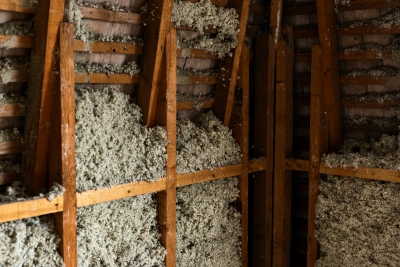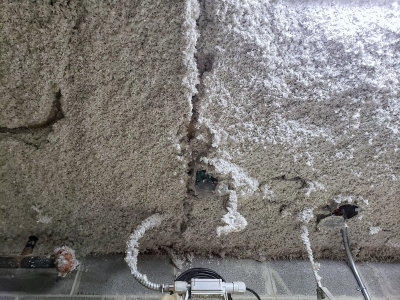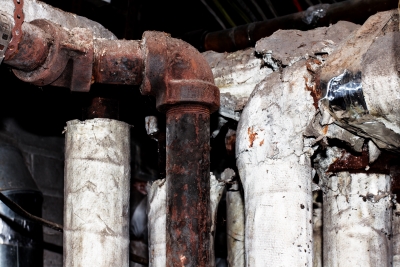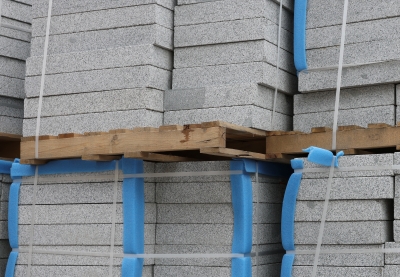Asbestos Insulation: A Complete Guide
Insulation plays an important role in construction. It holds in heat, stops fires from spreading and reduces noise, making it essential in both commercial and residential buildings. But many older insulation materials were made with asbestos—a hidden danger that harmed countless workers and their families.
If you’ve been diagnosed with mesothelioma and worked with asbestos insulation, learn more about your legal right to compensation.
What Is Asbestos Insulation?
Asbestos insulation is any type of insulation that was made using asbestos fibers. Asbestos is strong, heat-resistant and inexpensive, and was mixed with insulation to help it last longer and handle high temperatures. You could find asbestos in attic insulation, wall insulation, spray-on insulation and wrap insulation used on hot water pipes, air ducts, boilers and wires.
Asbestos insulation was used in construction from the 1930s through the 1980s. During this time, it was installed in homes, office buildings, schools, factories and military bases across the country. In 1973, the U.S. Environmental Protection Agency (EPA) banned spray-on asbestos products. But the asbestos ban didn’t apply to other types of insulation, and companies continued using it even after they knew the dangers. Today, asbestos insulation may still be in older buildings and could pose a risk for workers during repairs or demolition.
What Does Asbestos Insulation Look Like?
It’s nearly impossible to tell if insulation has asbestos just by looking at it. Asbestos insulation came in several different forms, and every type has risks. If insulation was installed before the late 1980s, it’s safer to assume it may have asbestos. The only way to know for sure is to have suspected asbestos products tested by a professional.
Loose-Fill Insulation

Asbestos loose-fill insulation, also called asbestos blown-in insulation, looks like fluffy gray or white clumps and is usually found in attics and wall cavities. It was poured or blown into place to fill gaps and create a thermal barrier.
Some types of this asbestos attic insulation were actually made using vermiculite, a different mineral that formed alongside asbestos and could be contaminated.
Spray-On Insulation

Spray-on insulation was often used in industrial, commercial and military buildings. Workers sprayed it directly onto beams, walls and ceilings, as well as boilers, furnaces and pipes to protect against fire and heat. It has a rough, bumpy surface and often flakes or crumbles over time. This type of asbestos insulation is very friable, which means that it’s easy to disturb. Both spraying and removing it could release large amounts of asbestos dust into the air.
Wrap Insulation

Wrap insulation was used to cover hot water pipes, air ducts and steam systems. Asbestos wiring insulation was also typically wrapped. This asbestos insulation looked like cloth or paper wrapped around pipes or a plaster-like coating applied by hand, and it was very common on Navy ships and in industrial buildings. It helped prevent heat loss and protected workers from burns, but over time, it could become friable, making it a health risk in close quarters like ships.
Block Insulation

Block insulation was formed into solid panels or blocks and used to line furnaces, tanks and ovens because it was fireproof and resistant to high heat. It was also a common type of asbestos wall insulation, especially for industrial buildings. The blocks contained high amounts of asbestos and were often cut to fit into place, creating a lot of dust that could be inhaled.
Health Risks of Asbestos Insulation Exposure
Asbestos insulation is one of the most dangerous forms of asbestos because of how easily it can release fibers. When insulation is sawed, drilled, cut or removed, it can send tiny asbestos fibers into the air. If it’s broken down enough, even touching it can create dust. These fibers are invisible, and workers inhaled them without knowing. Once they get trapped in the lungs or abdomen, they can cause asbestos-related diseases like mesothelioma, lung cancer and asbestosis.
Mesothelioma is a rare cancer caused by asbestos exposure, especially consistent exposure over long periods of time. It takes a long time to develop—up to 10 to 50 years in some cases—meaning many workers aren’t aware they could be at risk. Because insulation was used so widely and can break down easily, workers who handled it regularly have a higher risk of mesothelioma.
Occupations At-Risk of Asbestos Insulation Exposure
Most asbestos insulation exposure happened on the job. While today’s workers have safety rules to protect them, you can still be exposed during building repairs or if your employer doesn’t follow those rules. People most likely to come into contact with asbestos insulation include:
- Boiler workers
- Construction workers
- Demolition crews
- Electricians
- HVAC workers
- Insulators
- Maintenance workers
- Navy veterans and other military service members
- Plumbers and pipefitters
- Shipyard workers
Family members were sometimes exposed too. Workers may have come home with asbestos fibers on their clothes, shoes or gear. Loved ones who did laundry or hugged them at the end of the day could have unknowingly been at risk of secondary asbestos exposure.

A complete guide delivered next day to your doorstep. Treatment Information, top doctors & cancer centers, financial assistance and more.
Legal Rights and Compensation for Asbestos Exposure
In many cases, the companies that made or sold asbestos insulation knew the risks but continued to use the material without proper warnings. If you or someone in your family has mesothelioma from exposure to asbestos insulation, you may have legal options to help you recover costs related to treatment, lost wages and other challenges you're facing.
Filing a Mesothelioma Lawsuit
A mesothelioma lawsuit is a legal claim filed against the companies responsible for your asbestos exposure. These cases are based on the fact that the company knew about the dangers and failed to act.
Filing a lawsuit for asbestos insulation exposure can help cover medical expenses, lost income and pain and suffering. A mesothelioma attorney with experience in asbestos cases can guide you through each step of the process, from gathering records to negotiating or going to trial.
Asbestos Claims and Other Compensation
Some companies that made asbestos insulation declared bankruptcy but were required to set up asbestos trust funds for future claims. Filing a claim with one of these trust funds may allow you to receive compensation even if the company no longer exists. In some cases, you might also qualify for workers’ compensation or veterans’ benefits.
A knowledgeable attorney can review your history and help you file the claims you’re eligible for so you don’t miss out on any of the compensation you deserve.
Notable Lawsuit and Settlement Amounts
ELSM Law has helped many workers and their families file an asbestos claim and get justice:
- An 83-year-old Rhode Island man who was diagnosed with peritoneal mesothelioma received a $6 million settlement. He worked for a large spray insulation company where he operated a sprayer for several years.
- A 53-year-old Connecticut man received a $4.7 million settlement. He was an insulator and a Navy veteran with a long history of working in asbestos-exposed environments.
- A 57-year-old Minnesota insulator and pipefitter received a $3.7 million settlement. He worked on several commercial and industrial sites, where he regularly handled asbestos insulation.
The amount of compensation will vary depending on the details of your case. Our experienced legal team will assist you in getting as much as possible.
Known Asbestos Insulation Companies
Asbestos companies supplied insulation to construction sites across the country. If you worked with or around insulation from one of these companies, you may have been exposed to asbestos without even knowing it:
- Armstrong Contracting and Supply Corporation
- Celotex
- CertainTeed Corporation
- Combustion Engineering
- Crown Cork & Seal
- E. Thurston & Sons
- E.J. Bartells Company
- Eagle-Picher Industries
- Ehret Magnesia
- Fibreboard Corporation
- Flintkote Company
- Forty-Eight Insulation, Inc.
- GAF Corporation
- Garlock Sealing Technologies
- General Refractories Company
- Johns Manville Corporation
- Kaiser Aluminum and Chemical Corporation
- Keasbey & Mattison
- Keene Corporation
- M. H. Detrick Company
- Metalclad Insulation Corporation
- National Gypsum Company
- Nicolet, Inc.
- Owens-Corning
- Owens-Illinois
- P. Green Industries
- Pacor Incorporated
- Pittsburgh Corning
- Quigley Co.
- Rock Wool Manufacturing Company
- Shook & Fletcher
- U.S. Gypsum Company
- Unarco
- W.R. Grace
- Western MacArthur
Steps to Take If You Suspect Asbestos Insulation
If you believe there may be asbestos insulation in your home, don’t touch or disturb it. Contact a licensed professional to test the material and remove it safely. Workers who handle renovation or repair jobs should also take steps to protect themselves, especially when dealing with older buildings.
If you’ve been diagnosed with mesothelioma and think asbestos insulation may be the cause, reach out to a lawyer as soon as possible. At Early, Lucarelli, Sweeney and Meisenkothen, our team has decades of experience helping families like yours. Contact us for a free case evaluation. We’ll listen to your story, answer your questions and help you take the next steps.
FAQs
What are the types of asbestos insulation?
Asbestos insulation comes in a few common forms, including loose-fill, spray-on, block and pipe wrap insulation. Depending on where they were used, they could appear soft and fluffy, hard and cement-like or wrapped like cloth. Understanding what kind of insulation was used where you worked can help identify the source of your exposure.
Does all insulation have asbestos?
No, not all insulation contains asbestos, but many types used before the late 1980s did. Modern insulation is made from safer materials like fiberglass or foam. Still, older insulation in walls, ceilings and attics may contain asbestos if it was installed before safety rules changed.
What does asbestos attic insulation look like?
Asbestos attic insulation often looks like loose gray or white material, but it can also appear dusty or stringy, depending on the type. It may also be hiding under newer insulation if the attic was renovated. It’s nearly impossible to tell if insulation contains asbestos, so it’s safest to get it tested.
Does pink insulation contain asbestos?
It could—the color of insulation doesn’t determine whether or not it contains asbestos. If the asbestos insulation was installed before the late 1980s, it’s best to get it tested, regardless of the color. Today, pink insulation is no longer made with asbestos.
What can I do if I was exposed to asbestos insulation?
If you were exposed to asbestos insulation and have been diagnosed with mesothelioma, you may be eligible for legal compensation. An experienced asbestos attorney can help you understand your legal rights and guide you through the process of filing an asbestos insulation lawsuit, recovering money from an asbestos trust fund or applying for workers’ compensation or veterans’ benefits if you’re eligible.
When should I reach out about an asbestos insulation mesothelioma claim?
You should contact an attorney as soon as you or a loved one has been diagnosed with mesothelioma. Most states have a time limit, called a statute of limitations, for filing a claim—often around two years. Waiting too long can make it harder to file, even if you have a strong case. The sooner you act, the better chance you have of securing compensation.
Request a Free Case Evaluation
Request a free case evaluation now if you or someone you love has been diagnosed with mesothelioma. The evaluation will cost you nothing. Our lawyers will travel to visit you at your convenience or conference call with you over the phone. We understand how difficult a time this is for you and will assist in any way that we can. You can also call us toll-free at 1-800-336-0086 at any time.




